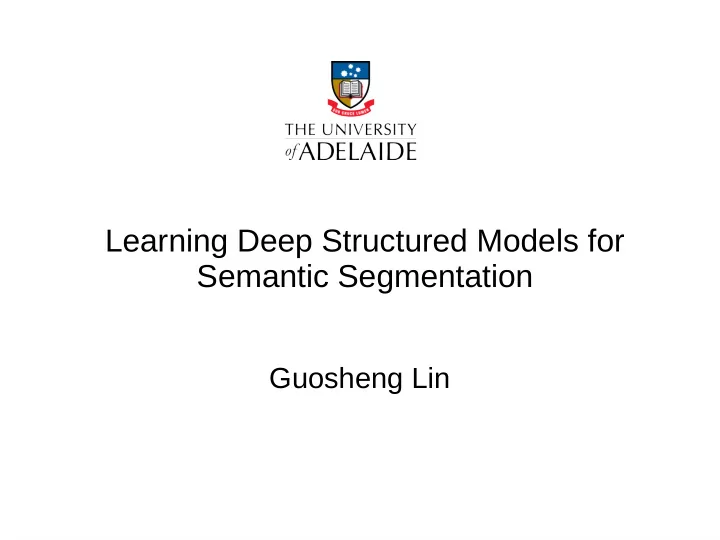

Learning Deep Structured Models for Semantic Segmentation Guosheng Lin
Semantic Segmentation
Outline ● Exploring Context with Deep Structured Models – Guosheng Lin, Chunhua Shen, Ian Reid, Anton van dan Hengel; Efficient Piecewise Training of Deep Structured Models for Semantic Segmentation; arXiv. ● Learning CNN based Message Estimators – Guosheng Lin, Chunhua Shen, Ian Reid, Anton van dan Hengel; Deeply Learning the Messages in Message Passing Inference; NIPS 2015.
Background ● Fully convolution network for semantic segmentation – Long et al. CVPR2015 low resolution prediction Prediction in the e.g., 1/32 or 1/8 Size of the input image of the input image size Fully convolution net Bilinear upsample Score map
Background Recent methods focus on the up-sample and refinement stage. e.g., DeepLab (ICLR 2015), CRF-RNN(ICCV 2015), DeconvNet(ICCV 2015), DPN (ICCV 2015) low resolution prediction Prediction in the e.g., 1/32 or 1/8 Size of the input image of the input image size Bilinear upsample Fully convolution net and refine Score map
Background Our focus: explore contextual information using deep structured model low resolution prediction Prediction in the e.g., 1/32 or 1/8 Size of the input image of the input image size Bilinear upsample Contextual Deep and refine Structured model Score map
Explore Context ● Spatial Context: – Semantic relations between image regions. ● e.g., a car is likely to appear over a road ● A person appears above a horse is more likely than a dog appears above a horse. – We focus on two types of context: ● Patch-Patch context ● Patch-Background context
Patch-Background Context Patch-Patch Context
Overview
Patch-Patch Context ● Learning CRFs with CNN based pairwise potential functions. FeatMap-Net Create the CRF graph (create nodes and pairwise connections) Feature map
d Create the CRF graph (create nodes and pairwise connections) Feature map Generate pairwise connection Create nodes in the CRF graph One node connects to the nodes One node corresponds to one that lie in a spatial range box spatial position in the feature map (box with the dashed lines) … …
Patch-Patch Context ● Construct CRF graph Constructing pairwise connections in a CRF graph:
CRFs with CNN based potentials The conditional likelihood for one image:
CRFs with CNN based potentials The conditional likelihood for one image:
Explore background context FeatMap-Net: multi-scale network for generating feature map
Prediction ● Coarse-level prediction stage: – P(y|x) is approximated using the mean-field algorithm ● Prediction refinement stage – Sharpen the object boundary by leveraging low-level pixel information for smoothness. – First up-sample the confidence map of the coarse prediction to the original input image size. Then perform Dense-CRF. (P. Kr ahenb uhl and V. KoltunNIPS2012)
Prediction ● Coarse-level prediction stage: – P(y|x) is approximated using the mean-field algorithm ● Prediction refinement stage – Sharpen the object boundary by leveraging low-level pixel information for smoothness. – First up-sample the confidence map of the coarse prediction to the original input image size. Then perform Dense-CRF. (P. Kr ahenb uhl and V. KoltunNIPS2012)
CRF learning Minimize the negative log-likelihood: SGD optimization, difficulty in calculating the gradient of the partition function: Require marginal inference at each SGD. Since the huge number of SGD iteration and large number of nodes, this approach is not practical or even intractable. We apply piecewise training to avoid repeat inference at each SGD iteration.
Results
PASCAL Leaderboard http://host.robots.ox.ac.uk:8080/leaderboard/displaylb.php?challengeid=11&compid=6
Examples on Internet images
Test image: street scene
Result from a model trained on street scene images (around 1000 training images)
Road Building Side-walk Car
Tree Rider Fence Person
Result from a model trained on street scene images (around 1000 training images)
Result from PASCAL VOC model
Test image: indoor scene
Result from NYUD trained model (around 800 training images)
Result from PASCAL VOC trained model
Result from NYUD trained model
Message Learning
CRFs+CNNs Conditional likelihood: Energy function: CNN based (log-) potential function (factor function): The potential function can be a unary, pairwise, or high-order potential function Factor graph: a factorization of the joint distribution of variables CNN based unary potential: measure the labelling confidence of a single variable y1 y2 CNN based pairwise potential, measure the confidence of the pairwise label configuration
Challenges in Learning CRFs+CNNs Prediction can be made by marginal inference (e.g. message passing): CRF-CNN joint learning: learning CNN potential functions by optimizing the CRF objective, typically, minimizing the negative conditional log-likelihood (NLL) Learning CNN parameters with stochastic gradient descend. The partition function Z brings difficulties for optimization: For each SGD iteration: require approximate marginal inference to calculate the factor marginals. CNN training need a large number of SGD iterations, training become intractable.
Solutions ● Traditional approach: – Applying approximate learning objectives ● Replace the optimization objectives to avoid inference ● e.g., piecewise training, pseudo-likelihood ● Our approach – Directly target the final prediction ● Traditional approach aims to learn the potentials function and perform inference for final prediction – Not learning the potential function – Learning CNN estimators to directly output the required intermediate values in an inference algorithm ● Focus on message passing based inference for prediction (specifically Loopy BP). ● Directly learning CNNs to predict the messages.
belief propagation: message passing based inference A simple example of the marginal inference on the node y2: y1 y2 y3 Variable-to-factor Factor-to-variable message message Message: K-dimensional vector, K is the number of classes (node states) Variable-to-factor message: Factor-to-variable message: marginal distribution (beliefs) of one variable:
CNN message estimators ● Directly learn a CNN function to output the message vector – Don't need to learn the potential functions The factor-to-variable message: Input image region A message prediction function formualted by a CNN dependent message feature vector: encodes all dependent messages from the neighboring nodes that are connected to the node p by the factor F
Learning CNN message estimator The variable marginals estimated by CNN: Define the cross entropy loss between the ideal marginal and the estimated marginal: The optimization problem for learning:
Application on semantic segmentation
Recommend
More recommend